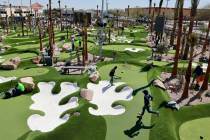Angel Park’s Mountain course maintains lofty status after 20 years
Two decades ago, PGA legend and prolific golf course architect Arnold Palmer teamed up with Ed Seay to create one of Southern Nevada's most complete golf centers, Angel Park Golf Club. Comprising two championship-length golf courses, the lighted Cloud Nine par 3 track, a grown-up miniature golf course and a spacious practice facility, Angel Park quickly established itself as a great place to tune the wrenches. Twenty years later, this local jewel has lost none of its luster, remaining a perennial Las Vegas Review-Journal "Readers' Poll" favorite and among the most popular golf destinations in the valley.
Angel Park has maintained its standing in the community by offering excellent conditions at a reasonable cost, a welcome combination given current economic times. Of the complex's two full-length tracks, Mountain is the more challenging, although the shorter Palm course -- with its numerous forced carries -- is a nightmare for those prone to worm-burners. Long, difficult par 4s are the stars on the par-71 Mountain course, which runs 6,722 yards from the tips and a comfortable 6,223 paces from the commonly used championship set.
The opening hole skirts past the edge of the neighboring Suncoast resort, although even banana-ballers stand no chance of reaching its gold-tinted windows. Of greater concern is the wide bunker jutting into the fairway from the right, which punishes players who take too large a bite off the dogleg. From the short grass, the approach is not overly taxing, although the upslope may warrant an extra club.
This course's greatest defense becomes immediately evident with the first putt; the slope from the adjacent mountains is so severe that upgradient putts refuse to roll, while anything headed toward the valley runs like a pickpocket. For added difficulty, many of the greens are domed like a tortoise shell.
After the front side's sole par 5 and a few short holes comes the 213-yard par-3 sixth, which is far easier than it appears from the tee box. A large bunker defends the front left portion of the putting surface, but other than that the green is surprisingly accessible. The only bad miss is deep, which can create double-bogey in an instant.
Coming through the turn, golfers have to run a gauntlet of three long, difficult par 4s. The first is the 444-yard No. 8 hole. The forced carry from the tee isn't particularly daunting, but the small fairway bunker along the left side is definitely in play. Just inside the right bunker, which is far beyond most players' reach, is an excellent line. Fortunately for mere mortals, the long approach does not have to navigate any greenside bunkers.
The 425-yard ninth, on the other hand, offers tee-to-green trouble. Shorter drivers should aim directly at the right fairway bunker; those with a bit more length can bisect the bunker and the 150-yard marker. Anything left of that is begging for a trip to the cattails that line the adjoined lakes.
As with the drive, the approach should favor the right side. While there is a finger bunker skirting the green's left edge, anyone who finds it should consider themselves fortunate that the errant shot didn't bound into the water.
The back side opens with a par 4 that spans 428 yards from the tips but plays less than 360 yards from the championship set, a surprising disparity in distance. Those who play the blues should take advantage of this gift, pounding a drive deep into the bulbous fairway to set up a wedge approach shot. While the deep bunker fronting the green can be problematic when the pin is forward, using a lofted club should help with distance control.
Three holes later, bombers have an opportunity to reach the 520-yard par 5 in two, while the rest of us try not to mess up what should be an easy three-short hole. Two small pine trees just left of the dual fairway bunkers provide a good target, setting up a straight rip at the green.
Both front edges of the putting surface are protected by traps, so those who give it a go must be precise with the run-up approach. Most players instead elect for a lay-up to optimal wedge distance.
No. 17, the return trip's other par 5, is far less inviting. At 557 yards, it represents the Mountain track's longest hole. Moreover, its ravine-divided fairway can make it a nightmare. Staring at a narrow strip of grass, the natural instinct from the tee box is to club down in order to take the looming desert along the right edge out of play.
However, those who leave the drive short or bail out left will be hard-pressed to clear the chasm between the two fairways. From anything other than optimal position, aim the second shot just inside the cart path and swing hard, as it's better to play from the rough than drop a new ball.
The Mountain course's final offering is a longish par 4 that looks more daunting than it is. While water lurks along the right side from tee to green, the wide fairway is receptive. The green isn't visible from the tee box, but a line just left of the 150-yard pole will take pressure off of the approach. The only bad miss on the final swing is right; any other position offers at least an opportunity for a closing up-and-down.
With perfect autumn temperatures and ideal course conditions, Angel Park's Mountain track is nothing less than heavenly. Frequent golfers should look into OB Sports' player's card, which provides enticing greens fees for those who consider lunch an intermission between rounds.
Angel Park Golf Club is located at 100 S. Rampart Blvd., adjacent to Summerlin Parkway. For more information or to reserve a tee time, call 254-4653 or visit angelpark.com.























